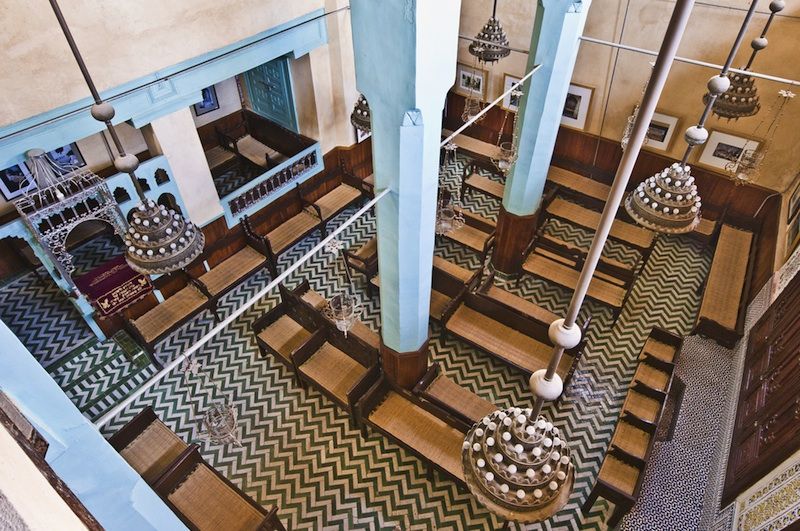Genes Tell Intricate Tale of Jewish Diaspora

A new genetic map paints a comprehensive picture of the 2,000 or so years in which different Jewish groups migrated across the globe, with some becoming genetically isolated units while others seemed to mix and mingle more.
The new findings allow researchers to trace the diaspora, or the historical migration, of the Jews, which began in the sixth century B.C. when the Babylonians conquered the Kingdom of Judah. Some Jews remained in Judah under Babylonian rule, while others fled to Egypt and other parts of the Middle East. Jewish migrations have continued into the present day.
The study researchers found that the genomes of Jewish North African groups are distinct from one another, but that they show linkages to each other absent from their non-Jewish North African neighbors. The findings reveal a history of close-knit communities prone to intermarriage, said study leader Harry Ostrer of the Albert Einstein College of Medicine in New York.
"Virtually all the Jewish groups we've studied tend to be quite closely related to one another," Ostrer said. "It would seem for most Jewish groups, there is a biological basis for their Jewishness which is based on their sharing of DNA segments."
Tracing Jewish genetics
Ostrer and his colleagues have been studying the genetics of Jewish groups throughout Europe and the Middle East, both to reconstruct the history of the religion and to investigate diseases such as the genetic disorder Tay-Sachs that disproportionately affect this population. In 2010, the group reported on the genetics of seven European and Middle Eastern populations. The new study, published today (Aug. 6) in the journal Proceedings of the National Academy of Sciences, expands the findings to a total of 15 groups, with the newest additions from Morocco, Algeria, Tunisia, Libya and the island of Djerba. [Photos: Ancient Jewish Treasure]
The researchers worked with local communities to get volunteers to offer blood samples for genetic analysis. The current study analyzed the genes of 509 unrelated North African individuals, comparing them across groups. Similar work has been done linking ancient Israeli and Syrian people to Ethiopia.
Sign up for the Live Science daily newsletter now
Get the world’s most fascinating discoveries delivered straight to your inbox.
The results revealed close relations between North African and European Jews, Ostrer said. The researchers also found two distinct groups of North African Jews, one comprised of Libyan and Tunisian Jews and the other of Moroccan and Algerian Jews. These groups were more likely to share DNA segments than other Jewish groups, indicating more shared genetic history.
"I like to think of Jewishness as a tapestry with these DNA segments representing the threads that weave the tapestry together," Ostrer said. Non-Jews can convert to Judaism, but membership in the group is also passed down along a matrilineal line, meaning Jewishness straddles the line between religion, ethnicity and culture.
A history of migration
The findings tended to track with what is known of the history of the Jewish Diaspora, or spread of the Jewish people, through North Africa. For example, there was evidence of gene-sharing between North African Jews and non-Jews, but generally not recently, the researchers found.
"This tends to fit the historical observation that during Islamic times from roughly the eighth century to roughly the 20th century, there was limited intermarriage between Jews and non-Jews," Ostrer said.
Among Moroccan and Algerian Jews, there was evidence of some mixing with the Sephardic Jews who trace their roots to the Iberian Peninsula. Again, the genetic results back up the known history of Sephardic Jews leaving Spain and Portugal, with some settling in Morocco and Algeria.
The findings help create a "comprehensive view of what the Jewish Diaspora was like," Ostrer said. Major times of movement included the classic period of Greek and Roman dominance, when Jewish groups migrated out of the Middle East and into Europe and North Africa, converting locals and intermarrying along the way. A second major migration occurred after the Spanish Inquisition in the late 1400s and early 1500s, a time when Jews and Muslims were ordered to convert to Catholicism or leave Spain. [10 Myths of Medieval Torture]
The most recent movement began in the late 1800s and continues today, with immigration to the United States, Israel, Canada, Australia and South Africa, Ostrer said.
The United States and Latin America tend to be a "melting pot" of genetics, Ostrer said — 50 percent to 60 percent of American Jews marry someone of a different religion or ethnicity — but the "Old World" genetics of European and North African Jews are helpful in understanding certain diseases.
In these populations, people married within their communities and even within their own families for centuries, allowing studies on relatively few people to be extrapolated more widely throughout the population. In a similar example, researchers recently found a gene that protects against Alzheimer's disease in Icelandic populations. Those results were reported July 21 in the journal Nature. The same sort of research is possible in Jewish populations, Ostrer said.
"It represents an extraordinary resource that is much harder to do, for instance, in the European-American population, because there has been such a melting pot occurring there," he said.
Follow Stephanie Pappas on Twitter @sipappas or LiveScience @livescience. We're also on Facebook & Google+.

Stephanie Pappas is a contributing writer for Live Science, covering topics ranging from geoscience to archaeology to the human brain and behavior. She was previously a senior writer for Live Science but is now a freelancer based in Denver, Colorado, and regularly contributes to Scientific American and The Monitor, the monthly magazine of the American Psychological Association. Stephanie received a bachelor's degree in psychology from the University of South Carolina and a graduate certificate in science communication from the University of California, Santa Cruz.











